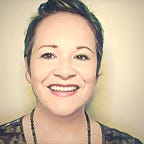Advocating for Better Futures: 5 actions to make your vision real
As advocates for social justice, we know that a better world is possible. But many people lose energy and commitment when faced with so much uncertainty. How can we share visions for a better world in ways that motivate people to stay involved? Ideas of what we would gain and what “better” looks like can help people weather the complexity of transition.
Here is a framework to bring elements of your vision to life. These actions turn missions into glimpses of the future to align audiences toward action for that future. Engaging with your vision can convince people that the struggle is worthwhile by evoking what that better world looks and feels like.
These actions can give audiences an experience of how that future could feel.
Imagine an antiracist task force at a small college. They are spending the summer exploring ways to share their visions for more liberatory forms of learning. They’ll create a series of installments and activities that demonstrate different kinds of knowledge. In September, students, staff, faculty, and the surrounding community will find moments on campus that invite them into the future of this institute. They’ll have a glimpse of a plan for a curriculum that embraces many ways of knowing and celebrates diverse lives.
Their glimpse of the future started by imagining the world they want, the learning experiences, the decision-making, and the partnerships they want to have on the best possible campus they can envision. Then they used this framework to bring those visions into the present:
Tangible Futures framework:
- Call Forth: Speaking as if the future is already here. As if you have already succeeded
- Reckon & Reframe: To reframe the past to make a better future seem more possible
- Align: To embody the better world we imagine
- Demonstrate: To perform what we want to create. To provide a visceral understanding to inspire new possibilities
- Prototype: To test out ideas for the future to learn and iterate. Experiments on a small scale to understand and grow
We can use words or actions to give people a sense of future possibilities. Advocates can use this framework to evoke, perform, and test out compelling ideas of how equity might look and feel in the future. It is helpful in workshops; this tool sparks imaginations and gives advocates ways to make their visions tangible.
Try it yourself:
IMAGINE:
If your advocacy work was ridiculously successful– what would be possible?
- What signs of success would you see?
- How would people feel in that world?
- What new jobs, communities, events, rituals could exists in that world?
EVOKE:
Call Forth:
- What are the possible roles, titles, attributes, and qualities of communities that will exist when we manifest our utopian visions?
- What incredible transformations, upheavals, rituals, or accomplishments might our future selves look back on with pride?
- How will it feel to live in a world where your revolution has been successful?
Reckon & Reframe:
- How can we engage more deeply with the history that has led to our present-day situation?
- What new perspectives on our history can pave the way for a deeper understanding of equity?
- What truths about the past unlock ways to reframe the work we are doing today and the world we are creating for the future?
Align:
- Where are our actions today not in-line with the values we want to carry into the future?
- What are the qualities of the world we are working toward?
- How will people behave differently when our vision is achieved?
Demonstrate:
- What aspects of our future vision do people need to see in action to believe they are possible?
- What opportunities do we have to engage people in a glimpse of a just world?
- Are there events or locations that we can take over and create an insulated demonstration of what is possible?
Prototype:
- What elements of our future vision can we learn more about through rehearsal?
- What are the most controversial aspects of our proposal? How can we build experiments to explore these concerns?
- What would it look like to experience this future world for five minutes or one hour?
